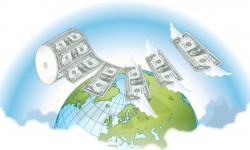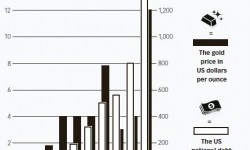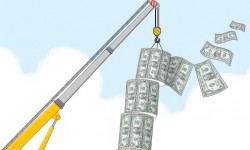Debt – the sword of Damocles
After the recent global economic downturn, countries around the world are struggling to bring down their level of debilitating debt. It’s payback time.
A recent Facebook post from Forbes magazine reported how toilet paper was shrinking in size to allow manufacturers to cut quantity while maintaining price.
After all, in a weak global economy offering less of a product at the same price is easier than raising prices. Less for the same price is inherently a price increase that won’t scare away consumers. More-over, it doesn’t naturally fit into whatever inflation tracking mechanisms different countries use, as the price remains the same.
So what does shrinking toilet paper have to do with the global debt crisis that has seen countries such as Iceland, Greece, Latvia, Ireland, Dubai and Ukraine default, or almost default, on their sovereign debt?
In the incredibly complex interplay of interest rates, currencies, inflation and payment mechanisms that underpin the world economy, debt is like the ballast of a boat. It controls stability, promising not only a smoother but a faster ride. Highways are built on debt. Cars and houses are purchased on debt. So debt, generally, is good.
At the same time, when a nation’s debt becomes bigger than its overall output (or the debt to gross domestic product ratio is above 100 percent) or when an individual’s debt is more than he or she can handle, the country or individual becomes insolvent. Ways must be found either to slow spending or to increase income. So the sword of excessive debt threatens to cut growth, which means fewer jobs and lower living standards for everyone. In other words, high debt slows growth.
This is not only a central banker’s conundrum. Political authorities that control spending must also make hard choices as to which entitlements to cut or scrap for everyone from the poor to the military.
So surviving, which most of the Western world is trying to do these days, means coming up with acceptable mixes of spending cuts and tax increases to restore economic growth. Growth is the silver bullet.
This was the formula US President Barack Obama’s bipartisan debt-reduction commission eyed in late 2010, even though the commission was criticized by both Republicans and Democrats. It’s the beginning of a no-holds-barred political process to be played against the presidential election in 2012.
According to one rough estimate from the debt clock of The Economist magazine, global debt amounts to about 10,000 US dollars per person on the planet.
In the US, the national debt is estimated to be around USD 14 trillion, as projected on a screen in Times Square in New York City. With a GDP of 14.6 trillion, the US debt-to-GDP ratio is around 96 percent. Greece’s ratio when it was at its worst in May/June 2010 was 133 percent.
In November 2010, Ben Bernanke, chairman of the US Federal Reserve and probably the most powerful economist in the world, announced a USD 600 billion stimulus package to buy more US Treasury bonds.
“Easier financial conditions will promote economic growth,” Bernanke wrote in the Washington Post at the time of the stimulus package. “Higher stock prices will boost consumer wealth and help increase confidence, which can also spur spending. Increased spending will lead to higher incomes and profits that, in a virtuous circle, will further support economic expansion.”
What the Federal Reserve is doing is basically printing more money for the banks that have already been bailed out so they can lend more. The programme is intended to energize the economy by bringing down long-term interest rates to encourage more borrowing and spending.
“The most important thing that the United States can do for the world economy is to grow,” Obama told the Associated Press during the G20 (group of 20 finance ministers and central bank governors) summit meeting in Seoul, South Korea, in November 2010.
More dollars flooding the financial system will cause the dollar’s value to decline, making American products cheaper but also making foreign goods costlier in the US.
The Federal Reserve’s move has of course irked many foreign governments who historically have had foreign reserves in the form of US dollars, and with more dollars on the market, these holdings will inherently have less buying power.
“This is the kind of behaviour that can start trade wars,” says Rocky Vega, an editor at The Daily Reckoning, an email newsletter with more than 500,000 subscribers published by Agora Financial, a Baltimore-based financial research firm.
“Maybe Federal Reserve thinks US shoppers won’t notice when they are paying the same for less,” he writes.
Like toilet paper.
“And internationally, Fed’s trying out something similar,” Vega continues, “flooding the world with dollars in order to make US exports look less expensive abroad and the massive US debt look smaller, while in reality little about the US economy is changing. It’s just the dollar that’s being tinkered with.”
This explains why gold has never lost its lustre. As the dollar has eroded as a store of value, the yellow metal, which fetched USD 35 an ounce back in the 1960s, today is worth in the neighbourhood of USD 1,200 an ounce.
Politicians are trying to show they have the will if not to trim the debt at least to slow its growth. They talk of various policy mixes involving spending cuts and tax hikes.
France has already increased the retirement age by two years to reduce government outlays and rebuild social security funds that are already heavily leveraged.
So debt is both good and bad. The Economist’s global debt clock shows the fastest rate of debt accumulation is in North America, Europe and Australia. The clock is ticking.







